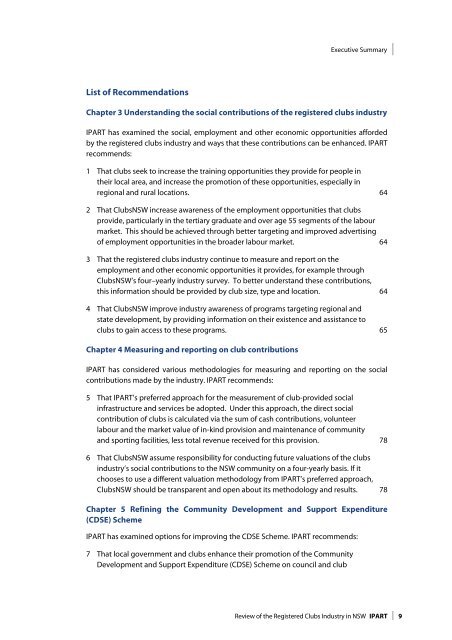Review of the Registered Clubs Industry in NSW - Clubs NSW
Review of the Registered Clubs Industry in NSW - Clubs NSW
Review of the Registered Clubs Industry in NSW - Clubs NSW
Create successful ePaper yourself
Turn your PDF publications into a flip-book with our unique Google optimized e-Paper software.
Executive Summary<br />
List <strong>of</strong> Recommendations<br />
Chapter 3 Understand<strong>in</strong>g <strong>the</strong> social contributions <strong>of</strong> <strong>the</strong> registered clubs <strong>in</strong>dustry<br />
IPART has exam<strong>in</strong>ed <strong>the</strong> social, employment and o<strong>the</strong>r economic opportunities afforded<br />
by <strong>the</strong> registered clubs <strong>in</strong>dustry and ways that <strong>the</strong>se contributions can be enhanced. IPART<br />
recommends:<br />
1 That clubs seek to <strong>in</strong>crease <strong>the</strong> tra<strong>in</strong><strong>in</strong>g opportunities <strong>the</strong>y provide for people <strong>in</strong><br />
<strong>the</strong>ir local area, and <strong>in</strong>crease <strong>the</strong> promotion <strong>of</strong> <strong>the</strong>se opportunities, especially <strong>in</strong><br />
regional and rural locations. 64<br />
2 That <strong>Clubs</strong><strong>NSW</strong> <strong>in</strong>crease awareness <strong>of</strong> <strong>the</strong> employment opportunities that clubs<br />
provide, particularly <strong>in</strong> <strong>the</strong> tertiary graduate and over age 55 segments <strong>of</strong> <strong>the</strong> labour<br />
market. This should be achieved through better target<strong>in</strong>g and improved advertis<strong>in</strong>g<br />
<strong>of</strong> employment opportunities <strong>in</strong> <strong>the</strong> broader labour market. 64<br />
3 That <strong>the</strong> registered clubs <strong>in</strong>dustry cont<strong>in</strong>ue to measure and report on <strong>the</strong><br />
employment and o<strong>the</strong>r economic opportunities it provides, for example through<br />
<strong>Clubs</strong><strong>NSW</strong>’s four–yearly <strong>in</strong>dustry survey. To better understand <strong>the</strong>se contributions,<br />
this <strong>in</strong>formation should be provided by club size, type and location. 64<br />
4 That <strong>Clubs</strong><strong>NSW</strong> improve <strong>in</strong>dustry awareness <strong>of</strong> programs target<strong>in</strong>g regional and<br />
state development, by provid<strong>in</strong>g <strong>in</strong>formation on <strong>the</strong>ir existence and assistance to<br />
clubs to ga<strong>in</strong> access to <strong>the</strong>se programs. 65<br />
Chapter 4 Measur<strong>in</strong>g and report<strong>in</strong>g on club contributions<br />
IPART has considered various methodologies for measur<strong>in</strong>g and report<strong>in</strong>g on <strong>the</strong> social<br />
contributions made by <strong>the</strong> <strong>in</strong>dustry. IPART recommends:<br />
5 That IPART’s preferred approach for <strong>the</strong> measurement <strong>of</strong> club-provided social<br />
<strong>in</strong>frastructure and services be adopted. Under this approach, <strong>the</strong> direct social<br />
contribution <strong>of</strong> clubs is calculated via <strong>the</strong> sum <strong>of</strong> cash contributions, volunteer<br />
labour and <strong>the</strong> market value <strong>of</strong> <strong>in</strong>-k<strong>in</strong>d provision and ma<strong>in</strong>tenance <strong>of</strong> community<br />
and sport<strong>in</strong>g facilities, less total revenue received for this provision. 78<br />
6 That <strong>Clubs</strong><strong>NSW</strong> assume responsibility for conduct<strong>in</strong>g future valuations <strong>of</strong> <strong>the</strong> clubs<br />
<strong>in</strong>dustry’s social contributions to <strong>the</strong> <strong>NSW</strong> community on a four-yearly basis. If it<br />
chooses to use a different valuation methodology from IPART’s preferred approach,<br />
<strong>Clubs</strong><strong>NSW</strong> should be transparent and open about its methodology and results. 78<br />
Chapter 5 Ref<strong>in</strong><strong>in</strong>g <strong>the</strong> Community Development and Support Expenditure<br />
(CDSE) Scheme<br />
IPART has exam<strong>in</strong>ed options for improv<strong>in</strong>g <strong>the</strong> CDSE Scheme. IPART recommends:<br />
7 That local government and clubs enhance <strong>the</strong>ir promotion <strong>of</strong> <strong>the</strong> Community<br />
Development and Support Expenditure (CDSE) Scheme on council and club<br />
<strong>Review</strong> <strong>of</strong> <strong>the</strong> <strong>Registered</strong> <strong>Clubs</strong> <strong>Industry</strong> <strong>in</strong> <strong>NSW</strong> IPART 9
















